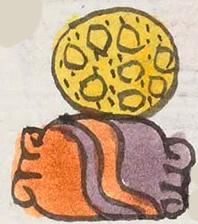Tecozauhtlan (Mdz16r)
This compound glyph for the place name Tecozauhtlan has two main components. One is a horizontal stone (tetl) with the usual alternating wavy lines of purple and terracotta orange and the curling ends. The other is a circle painted yellow with black dots and eight small circles mixed in among the dots, a cozauhqui (something turned yellow).
Stephanie Wood
The verb cozahui) means to turn yellow, so a stone that has turned yellow can be the tecozauhuitl, yellow ochre, which is the ultimate reading for the compound glyph. The locative suffix, -tlan, is either not shown visually (usually drawn from the phonetic value provided by tlantli, teeth), or the locative is implied in the rocky soil.
Stephanie Wood
tecoçauhtla. puo
Tecozauhtlan, pueblo
Stephanie Wood
c. 1541, or by 1553 at the latest
Stephanie Wood
nombres de lugares

tecozahui(tl), yellow ochre, https://nahuatl.wired-humanities.org/content/tecozahuitl
te(tl), stone, https://nahuatl.wired-humanities.org/content/tetl
cozahui, to turn yellow, https://nahuatl.wired-humanities.org/content/cozahui
cozauhqui, something yellow, https://nahuatl.wired-humanities.org/content/cozauhqui
-tlan (locative suffix), https://nahuatl.wired-humanities.org/content/tlan
Codex Mendoza, folio 16 recto, https://digital.bodleian.ox.ac.uk/objects/2fea788e-2aa2-4f08-b6d9-648c00..., image 42 of 188.
The Bodleian Libraries, University of Oxford, hold the original manuscript, the MS. Arch. Selden. A. 1. This image is published here under the UK Creative Commons, “Attribution-NonCommercial-ShareAlike 3.0 License” (CC-BY-NC-SA 3.0).





